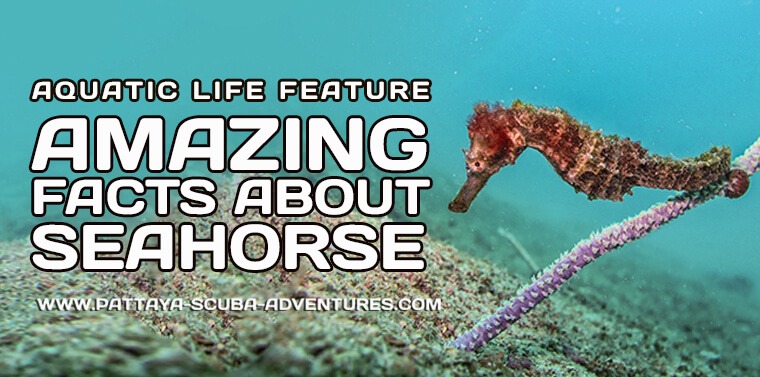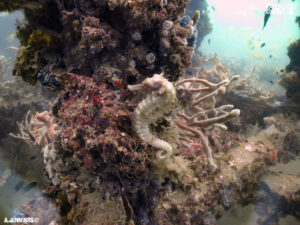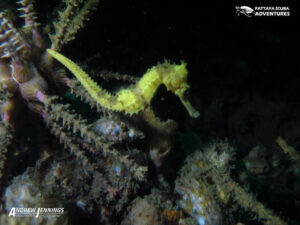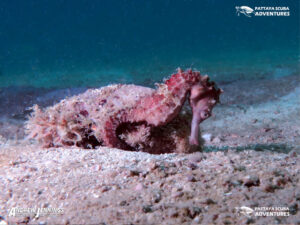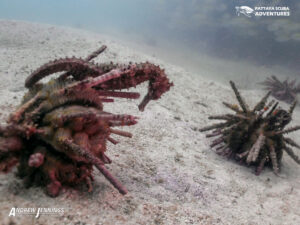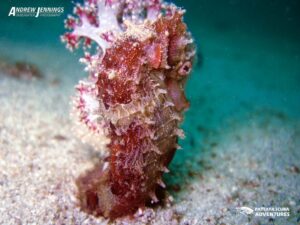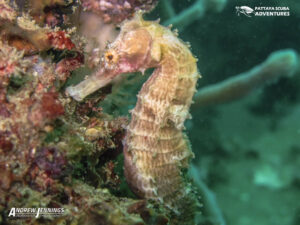Not Many People Know… Pattaya Has Many Seahorses!
Pattaya has certain dive sites where we always go to see Seahorse. Though they are usually well camouflaged if you know where to look then you can find them with relative ease.
There are about 40 known species of seahorse, 2 of which, the tiger tail seahorse, and the hedgehog seahorse, can be found right here diving in Pattaya.
Seahorses may be difficult to find but if you look closely at the pencil sea urchins all around the Pattaya Islands, you can find hedgehog seahorses anchoring themselves to the urchin’s spines. There are even tiger tail seahorses out over the sand by Koh Klung Badan.
Seahorses prefer to swim in pairs, and if you are lucky you will see them swimming along or dancing with their tails linked together.
They swim upright and avoid predators by mimicking the color of underwater plants. Except for crabs, the seahorse has very few marine predators because it is too bony and indigestible to be the top meal of the day!
Seahorses propel themselves through the water by using a small dorsal fin on their back that flutters. It can also be hard to see as it flutters up to 35 times per second! Seahorse also has pectoral fins located near the back of the head, which they use for maneuvering.
Although the Seahorse is a fast feeder, they are not great swimmers. Seahorses can easily die of exhaustion when caught in turbulent waters.
They anchor themselves with their prehensile tails to seagrasses and corals, using their elongated snouts to suck in zooplankton as it drifts by.
Seahorse a Big Eaters!
The seahorse can suck up food from as far as 3 cm away! They are big eaters! They actually, constantly feed on plankton and tiny fish. They have no teeth and no stomach, so food passes straight through their digestive systems resulting in them needing to eat, almost constantly to stay alive.
Seahorse Live & Love
Seahorses are monogamous, which means they mate for life. Another amazing fact is they are among the only animal species on Earth, where the male bears the unborn young. Nature’s way is that the Males become pregnant and this allows the females more time to make more eggs straight away and so reproduce faster! Seahorses take part in an eight-hour courtship ritual dance. They spin around, swim side by side, and change colors during this. We have seen this a few times diving here at a special dive site known locally as Seahorse City. This is a secret dive site kept off the daily dive trip menu so as not to disturb this dive site.
It was discovered back in 2014 during which time, we joined Project Seahorse and i-Seahorse in surveying our local Pattaya dive sites for seahorse.
It was surprising at the number of pregnant male seahorses we found in Pattaya. During mating, the female lays as many as 2,000 eggs in the male Seahorse pouch. The eggs are then fertilized inside the pouch and It will take between 2-6 weeks before the male squeezes his body to push groups of newborn seahorses out of the pouch. This can take two days and leave him exhausted. Less than one percent of young seahorses will make it to adulthood. As little as 5 or as many as 1,500 young can be born.
Why Are Seahorses called ‘Seahorses’?
We all know what a Seahorse looks like right!? tube-like snout with a small mouth at the tip. The head of this fish resembles a horse. Of course, this is most likely why we call them seahorses. Seahorses are scientifically classified in the family Syngnathidae, a name that comes from the Greek words for “jaw” and “together.” They are named for their equine appearance with bent necks and long-snouted heads followed by their distinctive trunk and tail.
i-Seahorse – Help Protect Seahorse
Seahorses are under threat from overfishing, habitat depletion, and pollution. Seahorses are exploited for traditional Asian medicines and as aquarium fish. Their habitats are among the most threatened marine environments.
Come diving in Pattaya and search for seahorses with us and you can help by Simply adding your observations and helping to identify seahorses on iSeahorse.org, You are contributing to seahorse knowledge and conservation. If you have an iPhone, be sure to download our app before you head out to dive with us.
All these Seahorses were spotted and photographed by our in-house Underwater Photographer Andrew Jennings.

